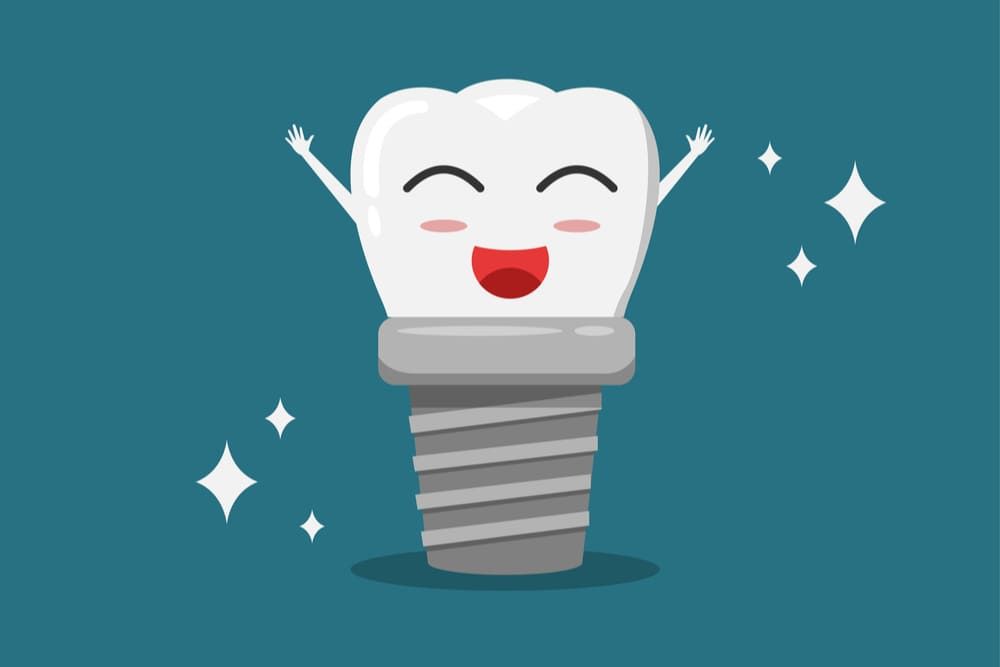Dental implants are artificial tooth roots that are anchored within the jaw bone to provide support to a dental prosthesis. They consist of three main parts: the implant, the abutment (connector), and the dental prosthesis which is usually a dental crown or denture. Because they are anchored within the jaw bone, they can effectively restore the aesthetics and function of a missing tooth or teeth.
Placing dental implants usually involves a somewhat invasive oral surgery. However, at Pasha Dental, Dr. Pasha utilizes the latest in dental implant technology. Guided implant dentistry uses a cone beam scan and a 3D printed or virtual model of the patient’s mouth to offer a safer, more predictable approach to the placement of dental implants.
Did you know
CBCT scans (cone beam computed tomography) are used before your actual procedure for Dr. Pasha to virtually place the implant. This means that he can accurately plan and execute his surgical approach without having you in the dental chair. He also uses these images to fabricate a surgical guide that is custom fit to your individual jaw bone.
Guided implant dentistry uses a surgical guide that has been customized to the patient’s mouth to limit the depths of the drill and implant, preventing damage to the jaw bone. Cross-sectional imaging (a CBCT scan) is also used to locate nerves, key structures, and the most ideal location for placement of the dental implant. This method also allows for the anticipated results of the procedure to be shown to patients prior to them undergoing the procedure. It also allows for the ideal placement of dental implants, resulting in highly successful treatments.
To see the difference Guided Implant Dentistry makes, click here! (Warning: some people may find this image graphic)
Frequently Asked Questions
Do I need dental implants?
You may need dental implants if you have severely damaged or decayed teeth, or teeth that are missing altogether. Dental implants help to prevent the bone loss that would otherwise occur if your missing teeth are not replaced. Life expectancy is increasing and with that is the need for long-lasting dental restorations. About 10 years ago there were about 35 million people in the US older than 65 years of age, in less than 10 years that number should double. Presently a 65 year old is expected to live 20 more years and by 2050, with an estimated 420 million people in the US, 21 million people, or roughly 5%, will be over 85 years of age. To find out if dental implants are the best restoration option for you, schedule a consultation with Dr. Pasha today.
What does a dental implant look like?
Endosteal implants are the most commonly used type of dental implants and are the type of implant used during a guided implant procedure. Endosteal implants have three main pieces: the implant, abutment, and dental prosthesis. Both the implant and the abutment will not be visible once the process is complete. In fact, the only visible portion is the dental prosthesis, which is usually a dental crown or denture.
The implant piece itself is made up of a tiny titanium screw. This titanium screw will be placed within the jawbone and will sit just below the gum line. The abutment sits within the implant acts at the connector between the implant and the dental prosthesis. Although the abutment sticks out from the gums, it will not be visible once the process is complete because the dental prosthesis will be attached over it.
For those who are seeking a more esthetic approach, or a metal-free approach due to allergies, options for ceramic dental implants are becoming available with equal, widespread success. The advantage to ceramic dental implants is that the implant is white like a natural tooth and the implant body and abutment are fused into a single piece.
What should I expect during a guided implant procedure?
During your guided implant procedure, you will be properly sedated and anesthetized to maintain your comfort. Then, Dr. Pasha will use your CBCT scans to locate the best place to put your surgical guide. Once the surgical guide is placed, he will use it to precisely prepare and place your dental implant. Then the abutment will likely be attached to the implant and left poking out of the gum line. A provisional restoration will likely be placed. Your guided implant procedure is quick and should only take about 20 minutes per a single tooth and a little under an hour for a full arch.
Once your implants have been placed, you will need to let them fully heal for about 3-6 months. During this time, your jawbone will undergo a process called osseointegration, which is the gradual hardening of the bone tissue around the dental implants. This process is a key element in dental implant success, as it functions to secure the implants in place and gives them their strength. Throughout this process, Dr. Pasha will use an Osstell Idx unit to measure the Implant Stability Quotient (ISQ) and track implant osseointegration from immediately after placement to subsequent follow ups to ensure the implant is ready to be used. After the bone has fused and your implants are secure, your final restoration can be placed.
What should I expect after my guided implant procedure?
After your guided implant procedure, you can expect to feel sore and may experience mild swelling. You may also experience some minor bleeding the same day as your surgery, although guided implant procedures generally minimize post op bleeding. Your pain and swelling should also be minimized through the use of a guided implant procedure. Depending on your treatment plan, Dr. Pasha may prescribe you pain medication and/or antibiotics to take after surgery. These are to be taken as directed for the best treatment outcomes.
You will also need to make temporary diet changes while your dental implants heal and undergo osseointegration. To as not to disturb your implants during their healing, you will need to maintain a soft foods diet. In the days directly following surgery, it is also recommended to eat only cool foods as warm or hot foods can cause bleeding. About 2-3 days after surgery, you can eat a variety of soft foods including pasta, steamed veggies, fish (without bones), applesauce, eggs, beans, and soups. As you recover, you will be able to gradually move on to harder foods with the guidance of Dr. Pasha.
How long do dental implants last?
Dental implants can last an average of 10 years, but many cases can last anywhere from 20-30 years. Although it is not yet proven, it is estimated that dental implants placed using a guided implant procedure will last longer because their placement has been specifically calculated as the optimal position.
To help your dental implants last for as long as possible, you will want to maintain good oral habits such as brushing twice daily, flossing once daily, and visiting Pasha Dental for your regular checkup and cleaning at least twice a year. In addition, you will also want to avoid detrimental behaviors that could damage your dental implants such as biting your nails, chewing ice, using your teeth as an opener, and smoking.
Dr. Pasha Javaheri Saatchi provides friendly, compassionate dental services at the forefront of dental technology to the Brooklyn, NY area as well as to Staten Island, Queens, and Manhattan. To experience the best dental care in NYC, schedule a consultation today at Pasha Dental.



